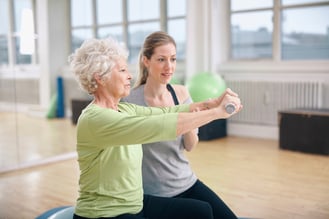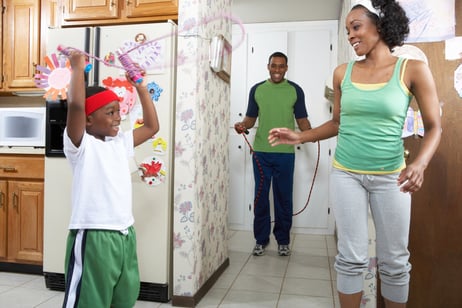.jpg?width=437&height=291&name=GettyImages-482404660%20(1).jpg) Regular physical activity is a major key when comes to living a healthy lifestyle and has many benefits. The biggest benefit is that physical activity helps improve your overall health overtime.
Regular physical activity is a major key when comes to living a healthy lifestyle and has many benefits. The biggest benefit is that physical activity helps improve your overall health overtime.
Regular physical activity can improve your heart health. The heart is to your body what an engine is to a car. Essentially, the heart makes the body go. Regular physical activity can improve the efficiency of the heart by lowering your blood pressure, reducing risk of a heart attack, and reduces risk of type 2 diabetes, heart disease, and some cancers. Regular physical activity can lead to increased bone, muscle, and joint strength which can lower risk of developing osteoporosis.
Regular physical activity is not something that just helps your heart, bones, and muscle health. Regular exercise has shown to improve our daily moods and contributes to increased and sustained energy. Studies have shown regular physical activity helps you feel more relaxed and helps improve our sleep and sleeping patterns. Moving our bodies is also great for the mind, a number of studies have shown that regular physical activity can help depression by blocking negative thoughts, and changing levels of chemicals in the brain, such as stress hormones, endorphins and serotonin levels. Incorporating regular activity into your day can help keep your thinking, learning and judgement skills sharp as you age.
Regular physical activity is also known to play a critical role in weight management, whether that is maintaining weight or losing weight. The easiest way to start your regular physical activity is walking. Walking for 30 minutes, 5 days a week can go a long way. This type of regular physical activity can increase the chances of living longer. The risk of premature death for adults 60 years and younger starts to level off right at around 8,000 and 10,000 steps a day.
Regular physical activity is a main component to living a healthy and sustainable lifestyle. With regular physical activity you are not only going to increase your health but change your quality of life. How do you plan to increase your physical activity this week?


 If music is good for the mind, and exercise is good for the body why not combine the two at the same time?
If music is good for the mind, and exercise is good for the body why not combine the two at the same time?.jpg?width=557&name=Raw%20Foods%20GettyImages-502130675%20(1).jpg)

 Lots of research has been done over the years to figuret out the best recipe for success when it comes to weight loss. Diet alone? Exercise alone? Or a combination of both? It should come as no surprise that the key for weight loss and keep it off is to combine a low-fat, lower-calorie diet with an exercise routine.
Lots of research has been done over the years to figuret out the best recipe for success when it comes to weight loss. Diet alone? Exercise alone? Or a combination of both? It should come as no surprise that the key for weight loss and keep it off is to combine a low-fat, lower-calorie diet with an exercise routine. 
 With exercise showing benefits such as improved balance, increased total-body strength, improved cognition, and reduction of chronic illness, it is difficult to understand why people would not exercise. However, there are two reasons why I think this “too much, too soon” judgment could arise in senior fitness:
With exercise showing benefits such as improved balance, increased total-body strength, improved cognition, and reduction of chronic illness, it is difficult to understand why people would not exercise. However, there are two reasons why I think this “too much, too soon” judgment could arise in senior fitness: 
 Every year the
Every year the 
 The holidays are right around the corner, and the first thing that comes to mind is all that food! You don’t want to look like a Santa at the start of the New Year! Well, don’t feel guilty about consuming the goodies; just get smart! If you have an understanding of what it takes to properly fuel your body, specifically as you age, the healthy eating process doesn’t seem so daunting. Older adults have different needs, and there are some key nutrients that are really important to maintain.
The holidays are right around the corner, and the first thing that comes to mind is all that food! You don’t want to look like a Santa at the start of the New Year! Well, don’t feel guilty about consuming the goodies; just get smart! If you have an understanding of what it takes to properly fuel your body, specifically as you age, the healthy eating process doesn’t seem so daunting. Older adults have different needs, and there are some key nutrients that are really important to maintain. 
 It seems that running injuries are all too common. There have been many research studies done on runners and, each year, as many as 79% of runners are sidelined due to injuries. Here are 5 ways to avoid injuries when running.
It seems that running injuries are all too common. There have been many research studies done on runners and, each year, as many as 79% of runners are sidelined due to injuries. Here are 5 ways to avoid injuries when running.  and activities for residents, I’m often surprised at what an afterthought their exercise amenities and services are. The clear appetite to provide residents with the very best options for living just doesn’t square with what’s in place for resident exercise at the community.
and activities for residents, I’m often surprised at what an afterthought their exercise amenities and services are. The clear appetite to provide residents with the very best options for living just doesn’t square with what’s in place for resident exercise at the community.
 We have all made the excuse that we don’t have the time to exercise. If you have children, this excuse is even more likely. You have to get the kids ready in the morning, you work all day, you get off work, pick up the kids, and take them to their after-school activities. After that you’re finally getting home to cook dinner and relax with the family. Upon finishing dinner, it’s time to shower and go to bed. Now, I know that may feel like an exhausting day and that you have no time for yourself, but if you really look for it there is plenty of time to fit in some exercise.
We have all made the excuse that we don’t have the time to exercise. If you have children, this excuse is even more likely. You have to get the kids ready in the morning, you work all day, you get off work, pick up the kids, and take them to their after-school activities. After that you’re finally getting home to cook dinner and relax with the family. Upon finishing dinner, it’s time to shower and go to bed. Now, I know that may feel like an exhausting day and that you have no time for yourself, but if you really look for it there is plenty of time to fit in some exercise. 